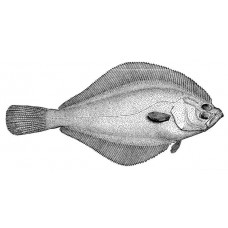Latin name
Hippoglossoides dubious
Other names
Hippoglossoides dubious
Identification
Body moderately tall, strongly compressed laterally, covered with ctenoid scales on the ocular side and cycloid scales on the blind side; body height 33-45.6% of standard body length. Head small; head length 26.9-28.8% of standard body length. Mouth large. Jaws symmetrical on each side of the body. The upper jaw is curved; the lower jaw is slightly forward. Teeth are small, numerous and arranged in a single row. On both jaws several front teeth are enlarged, fang-like. The eyes are on the right side of the body. The superior eye is on top of the head, but does not reach the upper profile. Interorbital space narrow, without ridge, covered with scales. Lateral line with 86-98 scales, well developed on both sides of the body, forming a low arc above the bases of the pectoral fins[2][3].
Features of fish fins
The dorsal fin begins at the top of the head above the upper eye and extends to the caudal peduncle; it has 76-92 soft rays, the anterior rays are not elongated. The anal fin has 59-70 soft rays. Pectoral fins with 8-12 rays are present on both sides of the body; the pectoral fin on the blind side of the body is smaller than on the ocular side. The pelvic fins have 6 rays. Caudal fin not joined to dorsal and anal fins; rounded, middle rays longest.
Fish colouring
The ocular side of the body is brown, with small black spots in juveniles. The rays of the dorsal and anal fins are yellowish-brown, the membranes between the rays transparent or yellow. The blind side of the body is whitish.
Distribution
Widespread in the northwestern part of the Pacific Ocean. They are found from the south of the Korean peninsula along the coast of Primorye, in Peter the Great Bay and north of the Tatar Strait and the Amur Liman. In the eastern Sea of Japan from mid-Honshu to northwest Hokkaido. In the Sea of Okhotsk from the northeast coast of Hokkaido and the southern Kuril Islands to Aniva Bay.
Habitat
Marine, oceanodromous, bottom-dwelling fish. They live at depths from 20 to 1200 m on sandy and muddy substrates. Temperate climate: 33°N to 53°N, 122°E to 158°E.
Size
The maximum length is 45 cm. According to other reports, they can reach a length of 52 cm and a weight of 1 kg.
Behavior
They make seasonal migrations, moving to the slope of the mainland in autumn. During the winter they are mainly sedentary at depths between 150 and 800 m at temperatures between -1 and +1 °C and do not feed during this period. In spring they return to the shelf to feed and spawn. Life expectancy is up to 14 years.
Food and feeding habits
The diet includes both typical bottom-dwelling organisms: crustaceans (true shrimp family Pandalidae), bivalves, ophiura; and pelagic organisms: bocoplaves (Hiperiidae), euphausiids, Sagittidae. Fish remains are sometimes found in the gastrointestinal tract.
Reproduction
Males first mature at the age of 3-4 years with a body length of 19-32 cm, and females at the age of 4-5 years with a body length of 20-37 cm. They spawn off Hokkaido in February-April, in Peter the Great Bay and off the coast of Primorye in April-July, and north of the Tatar Strait in May-August. Spawning occurs at depths of 30-100 m at bottom water temperatures of -0.45 to +8 °C. Eggs are pelagic, spherical, with a large perivitelline space, 2 to 2.94 mm in diameter. Fecundity ranges from 211 to 560 thousand eggs. Females hatch 2-3 portions of eggs during the spawning season. The incubation period is 4-5 days, depending on the temperature of the surface water. The length of the larvae at hatching is 2.6-3.4 mm.
Fishing
There is no specialised fishery. They are caught as by-catch, sometimes in large numbers.
Relationship with a person
They are sold fresh and frozen, and are also used in the production of canned food and fishmeal.
| Classification | |
| Phylum | Chordata |
| Class | Actinopterygii |
| Squad | Pleuronectiformes |
| Family | Pleuronectidae |
| Genus | Hippoglossoides |
| Species | H. dubius |
| Features | |
| Conservation status | Least Concern |
| Habitat | Bottom |
| Life span, years | 14 |
| Maximum body weight, kg | 1 |
| Maximum length, cm | 52 |
| Sailing speed, m/s | No information |
| Threat to people | Edible |
| Way of eating | Bentophage |
Flathead flounder
Tags: flathead flounder

